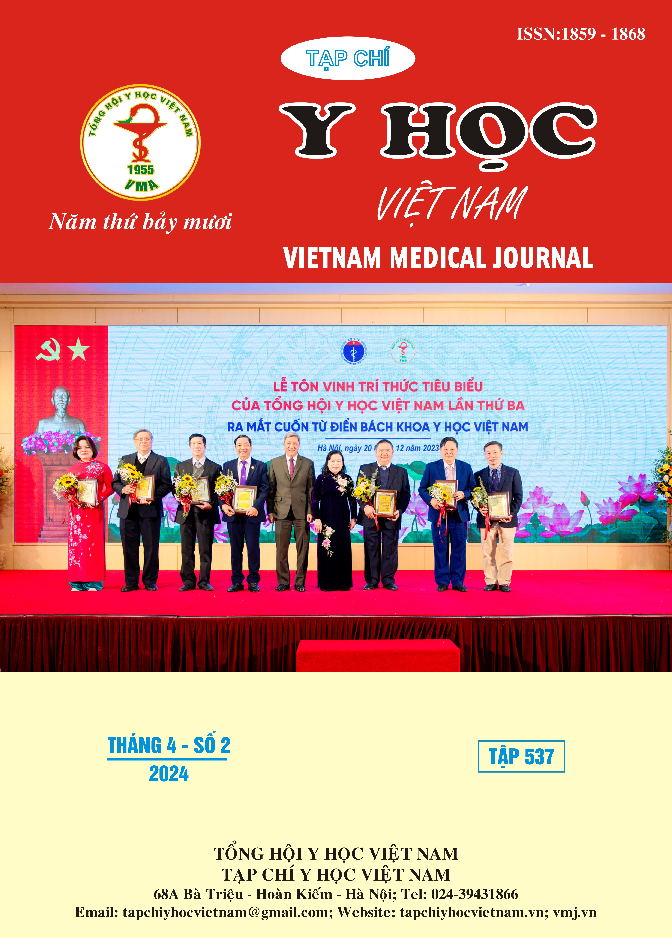EVALUATING THE CORRELATION BETWEEN NOCTURNAL OXYGEN DESATURATION PARAMETERS AND HBA1C IN PATIENTS WITH TYPE 2 DIABETES MELLITUS
Main Article Content
Abstract
Objective: This study aims to Evaluate the correlation between nocturnal hypoxemia parameters and HbA1c levels in patients with type 2 diabetes mellitus. Subjects and methods: A cross-sectional descriptive study was conducted on 96 type 2 diabetes patients at the Can Tho University of Medicine and Pharmacy Hospital from March 2023 to March 2024. Results: Regarding general characteristics, the majority of participants were female (64.6%), with an average age of 67.31 ± 12.9, and 43.8% were diagnosed with Obstructive Sleep Apnea (OSA). Clinically, most patients exhibited symptoms such as apnea/hypopnea, snoring, morning headaches, and waking up feeling tired (>85%). Polysomnographic features showed that the OSA group had significantly higher Apnea-Hypopnea Index (AHI) and Oxygen Desaturation Index (ODI) values than the non-OSA group (17.41 ± 13.28 vs. 7.1 ± 13.4 and 21.35 ± 14.95 vs. 8.31 ± 14.28, respectively, all p < 0.001). Additionally, the mean SpO2 was lower in patients with OSA compared to those without (p = 0.04). Correlation analysis revealed a positive correlation between HbA1c levels and both AHI and ODI; however, these correlations were very weak and not statistically significant (all 0 < r < 0.2; p > 0.05). Conclusion: In patients with type 2 diabetes mellitus, classic symptoms of OSA are prominently displayed. Polysomnographic indices AHI, ODI, and mean SpO2 indicate more severe nocturnal hypoxemia in the OSA group compared to the non-OSA group. HbA1c levels showed a positive but very weak correlation with AHI and ODI indices, with no significant difference.
Article Details
Keywords
Obstructive Sleep Apnea, Type 2 Diabetes Mellitus, HbA1c, AHI, ODI
References
2. Durán J., Esnaola S., Rubio R., Iztueta A. Obstructive sleep apnea-hypopnea and related clinical features in a population-based sample of subjects aged 30 to 70 yr. Am J Respir Crit Care Med. 2001; 163(3 Pt 1):685-9. https://doi.org/10.1164/ajrccm.163.3.2005065.
3. Lopes C., Esteves A.M., Bittencourt L.R., Tufik S., Mello M.T. Relationship between the quality of life and the severity of obstructive sleep apnea syndrome. Braz J Med Biol Res. 2008; 41(10):908-913.https://doi.org/10.1590/S0100-879X2008005000036.
4. Vũ Hoài Nam (2016), Nghiên cứu đặc điểm lâm sàng, cận lâm sàng và các yếu tố nguy cơ của hội chứng ngưng thở lúc ngủ do tắc nghẽn, Luận án tiến sĩ Y học, Đại học Y Dược TP. Hồ Chí Minh.
5. Pamidi, S., & Tasali, E. Obstructive sleep apnea and type 2 diabetes: is there a link?. Frontiers in neurology. 2012; 3:216. https://doi.org/10.3389%2Ffneur.2012.00126.
6. Pillai, A., Warren, G., Gunathilake, W., & Idris, I. Effects of sleep apnea severity on glycemic control in patients with type 2 diabetes prior to continuous positive airway pressure treatment. Diabetes technology & therapeutics. 2011; 13(9):945-949. https://doi.org/10.1089/dia.2011.0005.
7. Rashid, N. H., Zaghi, S., Scapuccin, et al. The value of oxygen desaturation index for diagnosing obstructive sleep apnea: a systematic review. The Laryngoscope. 2021; 131(2):440-447. https://doi.org/10.1002/lary.28663.
8. Rundo JV. Obstructive sleep apnea basics. Cleve Clin J Med. 2019; 86(9 Suppl 1):2-9. https://doi.org/10.3949/ccjm.86.s1.02.
9. Vale, J., Manuel, P., Oliveira, et al. Obstructive sleep apnea and diabetes mellitus. Revista Portuguesa de Pneumologia (English Edition). 2015; 21(2):55-60. https://doi.org/10.1016/j.rppnen.2014.07.005.


